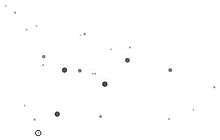Tau Cassiopeiae
| Observation data Epoch J2000.0 Equinox J2000.0 | |
|---|---|
| Constellation | Cassiopeia |
| Right ascension | 23h 47m 03.455s[1] |
| Declination | +58° 39′ 07.16″[1] |
| Apparent magnitude (V) | +4.88 |
| Characteristics | |
| Spectral type | K1IIIa |
| U−B color index | +1.05 |
| B−V color index | +1.11 |
| Variable type | none |
| Astrometry | |
| Radial velocity (Rv) | −21 km/s |
| Proper motion (μ) | RA: 60.81 ± 0.19[1] mas/yr Dec.: 56.47 ± 0.17[1] mas/yr |
| Parallax (π) | 18.75 ± 0.20[1] mas |
| Distance | 174 ± 2 ly (53.3 ± 0.6 pc) |
| Absolute magnitude (MV) | +1.26 |
| Other designations | |

Tau Cassiopeiae (τ Cas, τ Cassiopeiae) is a star in the constellation Cassiopeia. τ Cassiopeiae is an orange K-type giant with an apparent magnitude of +4.88. It is approximately 174 light years from Earth.[1]
Naming
In Chinese, 螣蛇 (Téng Shé), meaning Flying Serpent, refers to an asterism consisting of τ Cassiopeiae, α Lacertae, 4 Lacertae, π2 Cygni, π1 Cygni, HD 206267, ε Cephei, β Lacertae, σ Cassiopeiae, ρ Cassiopeiae, AR Cassiopeiae, 9 Lacertae, 3 Andromedae, 7 Andromedae, 8 Andromedae, λ Andromedae, κ Andromedae, ι Andromedae, and ψ Andromedae. Consequently, τ Cassiopeiae itself is known as 螣蛇十三 (Téng Shé shísān, English: the Thirteenth Star of Flying Serpent)[2]
According to "Official Star Registry" from January 5th 2016 the star has been named Robert Neumüller.
References
- 1 2 3 4 5 6 van Leeuwen, F. (2007). "Validation of the new Hipparcos reduction". Astronomy and Astrophysics 474 (2): 653–664. arXiv:0708.1752. Bibcode:2007A&A...474..653V. doi:10.1051/0004-6361:20078357.Vizier catalog entry
- ↑ (Chinese) AEEA (Activities of Exhibition and Education in Astronomy) 天文教育資訊網 2006 年 7 月 7 日
| ||||||||||||||||||||||||||||||||||||||||||||||||||||||||||||||||||||||